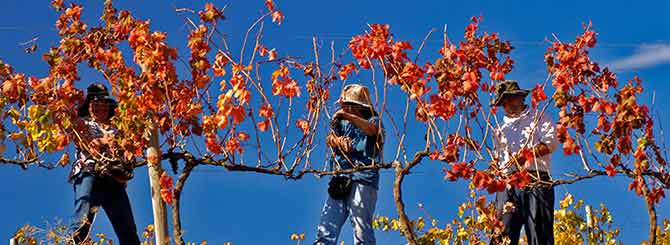Date£º
2014-11-24 09:21 Source£º
winesearcher Author:
Wink Lorch Translator:
Today marks the remarkable rebirth of a grape that was thought to have been lost for more than a century.

Vina Casa Silva | Towards the end of the growing season Carmenere's leaves turn bright red -it is usually the last variety to be picked.
If ever a wine grape deserved a "day" it is Carmenere, which celebrates the 20th anniversary of its rebirth today, having been discovered in Carmen's vineyards in Chile on Monday 24 November, 1994.
The U.S. branch of Wines of Chile has designated 24 November #CarmenereDay, encouraging chats via social media about the variety, with prizes of Coravin and Riedel glasses among the incentives.
In 1994, the French ampelographer Jean-Michel Boursiquot was on a visit to Chile to inspect the vineyards. At Carmen Vineyards in the Maipo district, south of the capital Santiago, he was shown a vineyard growing what his hosts termed Merlot Chileno -a variety they believed to be Merlot, but one that ripened late, perhaps because it had adapted to Chile's terroir.
Boursiquot inspected the leaf form and declared it was not Merlot at all and took cuttings back to France for further inspection. He reported back that this was a variety once grown in Bordeaux, but that was no longer present there, named Carmenere, also known as Grosse Vidure or Grande Vidure.
Putting this in the context of Chile's wine industry at the time, the discovery was a disaster. Exports were just starting to pick up and the two varieties enjoying the most success were Sauvignon Blanc and Merlot. Only a few years earlier, Chilean winemakers had discovered that much of their Sauvignon was in fact of the inferior Sauvignonasse, now known to be identical to Friulano. Now a French man was telling them that their Merlot wasn't Merlot at all.
The historical context
Back in the mid-18th Century, before phylloxera hit France, various Chilean landowners, made wealthy by copper mining, took the long journey to France and returned with a slice of French culture. They brought with them experts to help create grand chateau-style buildings and formal parks, and they even brought wine experts, along with the basis of what was needed to make fine wine ?cuttings of grape varieties from the great vineyards of France.
Among other varieties, Cabernet Sauvignon, Merlot, Pinot Noir, Semillon and Riesling all came to Chile then, as these were grown for the popular fine wines of Europe. For the record, Chardonnay was never brought over, because white Burgundy wasn't valued in Europe at the time.
Chile's vineyards never suffered from phylloxera partly because these cuttings were brought over before the disease ravaged Europe's vineyards -its isolation and growing conditions have kept it away since. Back in Bordeaux, when post-phylloxera plantings took place, the region dropped those varieties that weren't performing well, and that included the late-ripening Carmenere variety. Meanwhile, it continued to grow in Chile in the typical mixed vineyards of the time, along with other reds like Merlot and Cabernet.
Carmenere grows up
The Chilean Merlot being sold 20 years ago was a blend of real Merlot with Carmenere, usually with the former picked very ripe and the latter picked unripe and green. Once the discovery was made, it took more than a decade for Chilean producers to identify which was which throughout their vineyards, and to learn how to handle Carmenere on its own, and to identify its ideal terroir.
The first decade for Carmenere was a marketing nightmare. Firstly, consumers did not recognize the name and secondly, they often didn't like the bell pepper, herbaceous and sometimes meaty flavors that emerged from pure Carmeneres.
Carmen named its first pure Carmenere as Grande Vidure, but by 1996 the Carmenere name was appearing on labels.
Wine producers such as Carmen and Concha y Toro in Maipo, and Montes and Casa Silva in the Colchagua Valley, have worked hard to rehabilitate Carmenere, refining the techniques of growing it, the best time to pick and the best ways to make it. Clonal selection experiments are still ongoing.
Today, Chile's plantings of Carmenere are around 10,000 hectares (25,000 acres), more than 80 percent of the world's plantings. It is also being grown in a small way once again in Bordeaux, as well as in northern Italy (where it also suffered from confusion, this time with Cabernet Franc), and some is grown in Argentina, California, China and New Zealand.
Some of Chile's most in-demand wines include Carmenere as part of a blend with Cabernet Sauvignon and other Bordeaux varieties, including Casa Lapostolle's Clos Apalta and Errazuriz Sena.
But, today, varietal Carmenere has become a signature grape for Chile. Go grab a bottle for #CarmenereDay -the choice is endless, ranging from the inexpensive Concha y Toro Casillero del Diablo Carmenere through Casa Silva Coleccion, to the more serious Montes Purple Angel Carmenere.